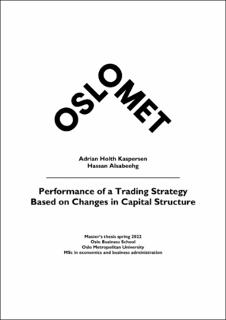| dc.contributor.advisor | Fjesme, Sturla | |
| dc.contributor.author | Alsabeehg, Hassan | |
| dc.contributor.author | Kaspersen, Adrian Holth | |
| dc.date.accessioned | 2022-10-05T10:31:07Z | |
| dc.date.available | 2022-10-05T10:31:07Z | |
| dc.date.issued | 2022 | |
| dc.identifier.uri | https://hdl.handle.net/11250/3023999 | |
| dc.description.abstract | Capital structure is a widely discussed topic in the financial literature. Previous research is
mixed regarding changes in capital structure and its impact on return on equities. It is well
documented in the literature that investors should invest in well-diversified index funds as they
give the best risk-adjusted return. More recent studies shows that investors can increase
their
risk-adjusted return from active strategies where the investors concentrate their portfolio by
analysis of companies and the market, see for example Fjesme (2019, 2020). In this article
we
examine whether a trading strategy that buys companies that reduce the debt ratio and short
sells companies that increase the debt ratio can beat the market at Oslo Stock Exchange.
This
is done by constructing portfolios based on data for all companies listed on the Oslo Stock
Exchange from January 2002 until November 2020. We document that it is possible to beat
the
market by following the strategy when adjusting for risk and the strategy generates up to
11.61% annual risk-adjusted excess return. | en_US |
| dc.language.iso | eng | en_US |
| dc.publisher | OsloMet – Oslo Metropolitan University | en_US |
| dc.subject | Capital structure | en_US |
| dc.subject | Risk-adjusted performance | en_US |
| dc.subject | Trading strategy | en_US |
| dc.subject | Active management | en_US |
| dc.title | Performance of a Trading Strategy Based on Changes in Capital Structure | en_US |
| dc.type | Master thesis | en_US |
| dc.description.version | submittedVersion | en_US |
